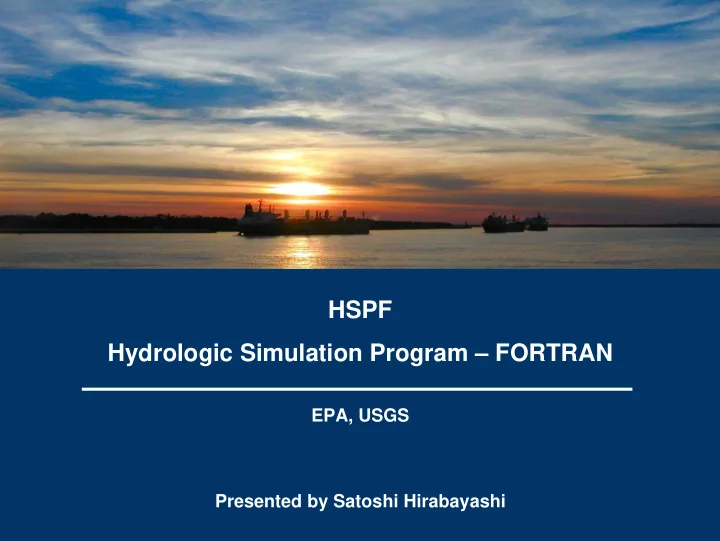

HSPF Hydrologic Simulation Program – FORTRAN EPA, USGS Presented by Satoshi Hirabayashi
4/30/2004 ERE645 Hydrologic Modeling Satoshi Hirabayashi Satoshi Hirabayashi Contents � Goals of HSPF � Goals of HSPF � HSPF development � HSPF development � Functions of HSPF � Functions of HSPF � Applications of HSPF � Applications of HSPF � Summary � Summary 10/27/2004 SUNY-ESF SUNY-ESF
4/30/2004 ERE645 Hydrologic Modeling Satoshi Hirabayashi Satoshi Hirabayashi Goals of HSPF HSPF is a comprehensive model to simulate the continuous event or the steady- HSPF is a comprehensive model to simulate the continuous event or the steady- state behavior of hydrologic and water quality processes on pervious/impervious state behavior of hydrologic and water quality processes on pervious/impervious land surface and in streams and well-mixed impoundments. land surface and in streams and well-mixed impoundments. Pervious Pervious Land Land Water Water Dynamic Dynamic Quantity Quantity Event Event Process Process Impervious Impervious Land Land HSPF HSPF Streams Streams Water Water Static Static Quality Quality Event Event Process Process Reservoirs Reservoirs 10/27/2004 SUNY-ESF SUNY-ESF
4/30/2004 ERE645 Hydrologic Modeling Satoshi Hirabayashi Satoshi Hirabayashi HSPF Development Evolution of the model HSPEXP HSPEXP USGS HSPF v11 HSPF v12 HSPF v11 HSPF v12 2001 1997 HSPF EPA HSPF winHSPF winHSPF 1980 NPS NPS Hydrocomp Inc. ARM ARM HSP HSP Stanford Stanford Stanford Watershed University Watershed Model Model 1966 1960’s 1970’s 1980’s 1990’s 2000’s � HSP (Hydrocomp Simulation Program) includes sediment transport and water quality simulation. � HSP (Hydrocomp Simulation Program) includes sediment transport and water quality simulation. � ARM (Agricultural Runoff Management Model) � ARM (Agricultural Runoff Management Model) � NPS (Nonpoint Source Pollutant Loading Model) � NPS (Nonpoint Source Pollutant Loading Model) � HSPF contains the capabilities of HSP, ARM and NPS, plus many extensions. � HSPF contains the capabilities of HSP, ARM and NPS, plus many extensions. 10/27/2004 SUNY-ESF SUNY-ESF
4/30/2004 ERE645 Hydrologic Modeling Satoshi Hirabayashi Satoshi Hirabayashi HSPF Functions Function Segmentation Water Quantity Process Water Quality Process Basic Adjusted Air Dissolved Carbon Basic Adjusted Air Dissolved Carbon Snow General WQ Snow General WQ Hydrology Temperature Oxygen Dioxide Hydrology Temperature Oxygen Dioxide Pervious Soil Water Soil Water Soil Erosion Pesticides Nitrogen Phosphorus Soil Erosion Pesticides Nitrogen Phosphorus Land Temperature Temperature Temperature Temperature Tracers Tracers Basic Adjusted Air Dissolved Carbon Basic Adjusted Air Dissolved Carbon Snow General WQ Snow General WQ Hydrology Temperature Oxygen Dioxide Impervious Hydrology Temperature Oxygen Dioxide Land Water Water Solids Solids Temperature Temperature Flow Water Dissolved Carbon Flow Water Dissolved Carbon General WQ General WQ Routing Temperature Oxygen Dioxide Routing Temperature Oxygen Dioxide Organic Organic Organic Organic Organic Organic Carbon Nitrogen Phosphorus Carbon Nitrogen Phosphorus Inorganic Inorganic inorganic Inorganic Inorganic inorganic Streams Carbon Nitrogen Phosphorus Carbon Nitrogen Phosphorus Benthic Reservoirs Benthic Sediment Pesticides Sediment Pesticides Algae Algae phytoplankton BOD zooplankton phytoplankton BOD zooplankton Conservativ Conservativ pH pH es es 10/27/2004 SUNY-ESF SUNY-ESF
4/30/2004 ERE645 Hydrologic Modeling Satoshi Hirabayashi Satoshi Hirabayashi HSPF Functions Software Structure � Structured programming. � Structured programming. � 3 modules (pervious land, impervious land, streams & reservoirs). � 3 modules (pervious land, impervious land, streams & reservoirs). � Each module contains specialized algorithms (sections). � Each module contains specialized algorithms (sections). 10/27/2004 SUNY-ESF SUNY-ESF
4/30/2004 ERE645 Hydrologic Modeling Satoshi Hirabayashi Satoshi Hirabayashi HSPF Functions Software Structure � For each hydrologic or water quality process, certain sections are used. � For each hydrologic or water quality process, certain sections are used. � Most processes are simulated by combination of sections. � Most processes are simulated by combination of sections. 10/27/2004 SUNY-ESF SUNY-ESF
4/30/2004 ERE645 Hydrologic Modeling Satoshi Hirabayashi Satoshi Hirabayashi HSPF Functions Example: Flow Routing Input HSPF Output Monthly Flow Monthly Flow Adjustment Factors Adjustment Factors Irrigation Withdrawal Irrigation Withdrawal Parameters Parameters Initial Conditions Initial Conditions RCHRES module RCHRES module Outflow Category Outflow Category HYDR section HYDR section Flow Routing Flow Routing Initial Volumes Initial Volumes Precipitation Precipitation Evaporation Evaporation Volume-dependent Volume-dependent Outflow Outflow Time-dependent Time-dependent Outflow Outflow � Input data should be fixed-formatted file to be able to read from the FORTRAN program. � Input data should be fixed-formatted file to be able to read from the FORTRAN program. � Output data is either printed tables at any time step, a flat file, or a WDM (Watershed Data � Output data is either printed tables at any time step, a flat file, or a WDM (Watershed Data Management) file. Management) file. 10/27/2004 SUNY-ESF SUNY-ESF
4/30/2004 ERE645 Hydrologic Modeling Satoshi Hirabayashi Satoshi Hirabayashi Applications of HSPF Potential applications of HSPF contain: � Assess the effects of land-use change � Reservoir operations � Point or nonpoint source treatment alternatives � Flow diversions � Flood mapping � Urban drainage studies � River basin planning � Studies of water erosion problems � In-stream water quality planning HSPF is accepted by the EPA as a tool for the development of TMDL (Total Maximum Daily Load) in the US. 10/27/2004 SUNY-ESF SUNY-ESF
4/30/2004 ERE645 Hydrologic Modeling Satoshi Hirabayashi Satoshi Hirabayashi Summary � The only available comprehensive model. � The only available comprehensive model. � Structured design based FORTRAN program. � Structured design based FORTRAN program. � Has evolved within 4 decades. � Has evolved within 4 decades. � Maintained by US EPA and USGS. � Maintained by US EPA and USGS. � Broad applications. � Broad applications. 10/27/2004 SUNY-ESF SUNY-ESF
Recommend
More recommend